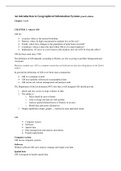Samenvatting
Samenvatting An Introduction to Geographical Information Systems, ISBN: 9780273722595 GIS
- Vak
- GIS
- Instelling
- Hogeschool Van Hall Larenstein (VHL)
Samenvatting voor an introduction to geographical information systems fourth edition voor de hoofdstukken 1 tot en met 10. Geschreven in het engels.
[Meer zien]





